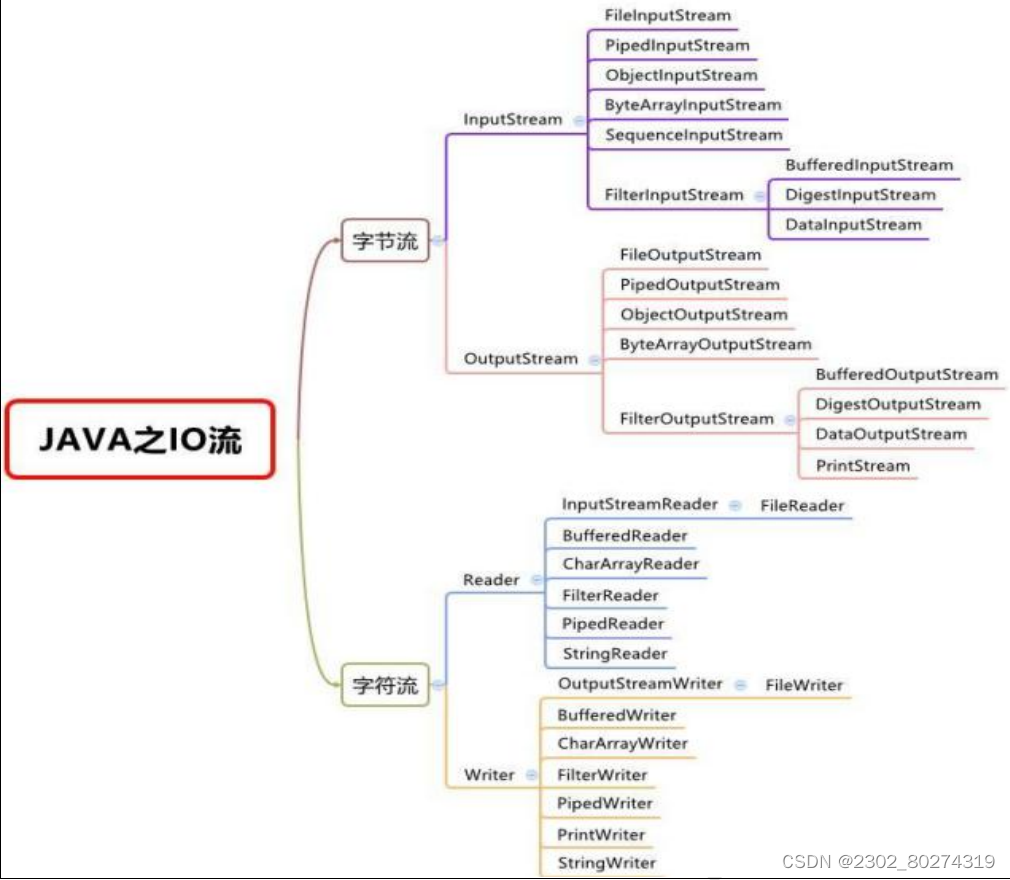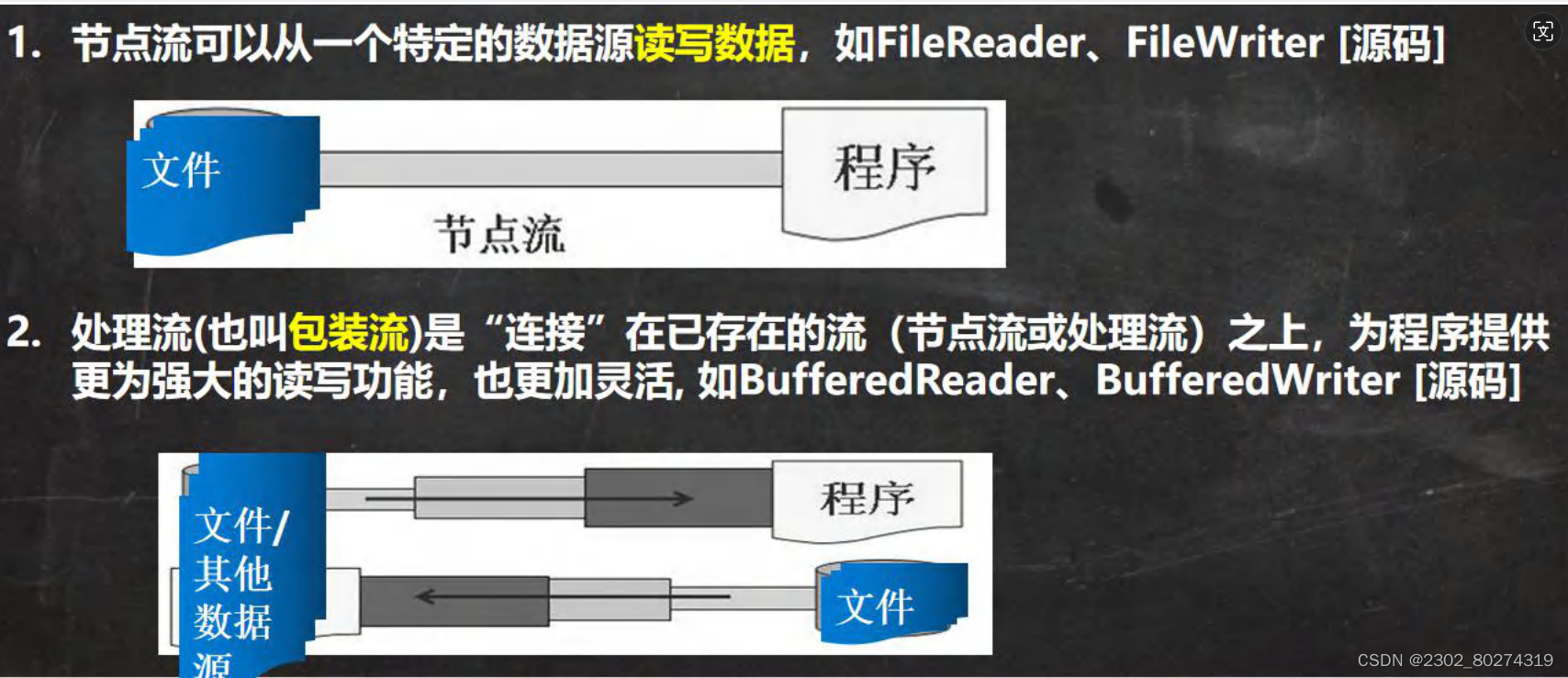IO流体系图-常用类
一、IO流体系图

二、IO流的具体使用
1.FileInputStream(字节输入流 文件->程序)
1.1fileInputStream.read()
返回的是int类型,要强制转化成char类型
从输入流中读取数据的下一个字节。返回 0 到 255 范围内的 int 字节值。如果因为已经到达流末尾而没有可用的字节,则返回值 -1。在输入数据可用、检测到流末尾或者抛出异常前,此方法一直阻塞。
子类必须提供此方法的一个实现。 返回:下一个数据字节;如果到达流的末尾,则返回 -1。
1.2fileInputStream.read(byte[]b)
import com.sun.org.apache.xpath.internal.operations.String;
import org.junit.jupiter.api.Test;
import java.io.FileInputStream;
import java.io.FileNotFoundException;
import java.io.FilterInputStream;
import java.io.IOException;
//FileInputStream的使用(字节输入流 文件->程序)
public class FileInputStream_ {
public static void main(String[] args) {
}
/*
演示读取文件
*/
@Test
public void readFile01(){
java.lang.String filePath = "d:\\java\\hello.txt";
int readData=0;
FileInputStream fileInputStream=null;
try {
//创建FileInputStream对象,用于读取文件
fileInputStream = new FileInputStream(filePath);
//从该输入流读取一个字节的数据,如果没有输入可用,该方法将阻止
//如果返回-1,表示读取完毕
while((readData = fileInputStream.read())!=-1){
System.out.print((char)readData);
}
} catch (IOException e) {
e.printStackTrace();
}finally {
//关闭文件流,释放资源
try {
fileInputStream.close();
} catch (IOException e) {
e.printStackTrace();
}
}
}
/*
使用read(byte[] b)读取文件,提高效率
*/
@Test
public void readFile02(){
java.lang.String filePath="d:\\java\\hello.txt";
int readData=0;
//字节数组
byte[] buf=new byte[8];//一次读取8个字节
int readLen=0;
FileInputStream fileInputStream=null;
try {
//创建FileInputStream对象,用于读取文件
fileInputStream = new FileInputStream(filePath);
//从该输入流读取一个字节的数据,如果没有输入可用,该方法将阻止
//如果返回-1,表示读取完毕
//如果读取正常,返回实际读取的字节数
while((readLen= fileInputStream.read(buf))!=-1) {
//将字符数组生成字符串
System.out.print(new java.lang.String(buf, 0, readLen));
}
} catch (IOException e) {
e.printStackTrace();
}finally {
//关闭文件流,释放资源
try {
fileInputStream.close();
} catch (IOException e) {
e.printStackTrace();
}
}
}
}
2.FileOutputStream
创建: 1.fileOutputStream = new FileOutputStream(filePath,true);,直接在文件末尾追加,保留原内容
2.fileOutputStream = new FileOutputStream(filePath),覆盖原内容,重新写入;
2.1fileOutputStream.write()写入一个字节
2.2fileOutputStream.write(byte[b])写入一个字符数组
str.getBytes[],将一个字符串转换成字符数组
import org.junit.jupiter.api.Test;
import java.io.FileNotFoundException;
import java.io.FileOutputStream;
import java.io.IOException;
public class FileOutputStream_ {
public static void main(String[] args) {
}
@Test
public void writeFile(){
//创建FileOutputStream
FileOutputStream fileOutputStream=null;
String filePath="d:\\java\\a.txt";
try {
//得到FileOutputStream对象
//new FileOutputStream(filePath),创建方式,当写入内容时,会覆盖原来的内容
//new FileOutputStream(filePath,true)创建方式,写入内容时,追加到文件后面
fileOutputStream = new FileOutputStream(filePath,true);
//写入一个字节
//fileOutputStream.write('H');
//写入一个数组
String str="hello,world!";
//str.getBytes()可以吧字符串->字符数组
fileOutputStream.write(str.getBytes());
} catch (IOException e) {
throw new RuntimeException(e);
} finally {
}
}
}
3.FileReader和FileWriter介绍
3.1FileReader方法
(1).new FileReader(File/String)
(2).read:每次读取单个字符,返回该字符,到文件末尾返回-1
(3).read(char[]):批量读取多个字符到数组,返回读取到的字符数,如果到文件末尾返回-1
字符数组转化为字符串
import org.junit.jupiter.api.Test;
import java.io.FileNotFoundException;
import java.io.FileReader;
import java.io.IOException;
public class FileReader_ {
public static void main(String[] args) {
}
@Test
public void readFile01(){
String filePath="d:\\java\\story.txt";
FileReader fileReader=null;
int data=0;
try {
fileReader = new FileReader(filePath);
//循环读取,使用read,单个字符读取
while((data=fileReader.read())!=-1){
System.out.print((char)data);
}
} catch (IOException e) {
throw new RuntimeException(e);
} finally {
if(fileReader!=null){
try {
fileReader.close();
} catch (IOException e) {
throw new RuntimeException(e);
}
}
}
}
@Test
public void readFile02(){
String filePath="d:\\java\\story.txt";
FileReader fileReader=null;
int readLen=0;
char[] buf=new char[8];
try {
fileReader = new FileReader(filePath);
//循环读取,使用read(buf),返回实际读取到的字符个数
while((readLen=fileReader.read(buf))!=-1){
//不能保证每次取出的都是8个字符,所有要截取读取的长度
System.out.print(new String(buf,0,readLen));
}
} catch (IOException e) {
throw new RuntimeException(e);
} finally {
if(fileReader!=null){
try {
fileReader.close();
} catch (IOException e) {
throw new RuntimeException(e);
}
}
}
}
}
3.2FileWriter方法
new String(char[]),将char[]转换成String
new String(char[],off,len),将字符串的指定部分转换成字符串
new FileWriter(File/String):覆盖模式,相当于流的指针在首端2)new FileWriter(File/String,true):追加模式,相当于流的指针在尾端 write(int):写入单个字符 write(char[]):写入指定数组 5)write(char[],off,len):写入指定数组的指定部分 6)write(string):写入整个字符串7)write(string,off,len):写入字符串的指定部分相关APl:String类:toCharArray:将String转换成char[]
import java.io.FileWriter;
import java.io.IOException;
public class FileWriter_ {
public static void main(String[] args) {
String filePath="d:\\java\\note.txt";
//创建FileWriter对象
FileWriter fileWriter=null;
char[]chars={'a','b','c'};
try {
fileWriter=new FileWriter(filePath);
//写入单个字符
fileWriter.write('H');
//写入指定数组
fileWriter.write(chars);
//写入指定数组的指定部分
fileWriter.write(" hello,world!".toCharArray(),0,6);
//写入整个字符串
fileWriter.write(" hihao");
//字符串指定部分
fileWriter.write(" 河北保定",0,3);
//数据量时,使用循环操作
} catch (IOException e) {
throw new RuntimeException(e);
} finally {
//最终一定要关闭流,或者flush才能真正把数据写进去
try {
fileWriter.close();
} catch (IOException e) {
throw new RuntimeException(e);
}
}
System.out.println("程序结束");
}
}
对于FileWriter,最后一定要关闭流,或者flush刷新才能将真正的数据写入到文件中
4.节点流和处理流


(1).节点流是底层流/低级流,直接和数据源相接
(2).处理流包装节点流,既可以消除不同节点流的实现差异,也可以提供更方便的处理方法完成输入输出。
(3).处理流对节点流进行包装,使用修饰器模式,不会和数据直接相连。
4.2处理流-BufferedReader 和 BufferedWriter
bufferedReader.readLine()//;按行读取,返回读取到的字符串
import java.io.BufferedReader;
import java.io.FileNotFoundException;
import java.io.FileReader;
import java.io.IOException;
//演示bufferedReader的使用
public class BufferedReader_ {
public static void main(String[] args) throws IOException {
String filePath="d:\\java\\story.txt";
//创建对象
BufferedReader bufferedReader = new BufferedReader(new FileReader(filePath));
//读取
String line;//按行读取
//bufferedReader.readLine();按行读取,返回读取到的字符串
while((line=bufferedReader.readLine())!=null){
System.out.println(line);
}
//关闭流,只需要关闭BufferedReader
//底层会自动去关闭节点流
bufferedReader.close();
}
}
1.创建BufferedWriter new FileWriter(filePath,true)表示以追加的方式写入 new FileWriter(filePath)表示以覆盖的方式写入
2.插入和系统相关的换行符
bufferedWriter.newLine();
import java.io.BufferedWriter;
import java.io.FileWriter;
import java.io.IOException;
public class BufferedWriter_ {
public static void main(String[] args) throws IOException {
String filePath="d:\\java\\ok.txt";
//创建BufferedWriter
//new FileWriter(filePath,true)表示以追加的方式写入
//new FileWriter(filePath)表示以覆盖的方式写入
BufferedWriter bufferedWriter = new BufferedWriter(new FileWriter(filePath,true));
bufferedWriter.write("hello1,world!");
//插入一个和系统相关的换行符
bufferedWriter.newLine();
bufferedWriter.write("hello2,world!");
bufferedWriter.newLine();
bufferedWriter.write("hello3,world!");
bufferedWriter.newLine();
bufferedWriter.write("hello4,world!");
bufferedWriter.newLine();
//关闭外层流,底层会自动关闭节点流(FileWriter)
bufferedWriter.close();
}
}
4.3处理流-BufferedInputStream 和 BufferedOutputStream
import com.sun.xml.internal.ws.policy.privateutil.PolicyUtils;
//字节流可以操作二进制文件,也可以操作文本文件
import java.io.*;
public class BufferedCopy02 {
public static void main(String[] args) {
String strFilePath="d:\\java\\io.PNG";
String destFilePath="d:\\java\\io1.jpg";
//创建BufferedInputStream和BufferedOutputStream
BufferedInputStream bis=null;
BufferedOutputStream bos=null;
try {
bis=new BufferedInputStream(new FileInputStream(strFilePath));
bos=new BufferedOutputStream(new FileOutputStream(destFilePath));
int readLen=0;
//循环读取文件,并写入到destFilePath
byte[] buff=new byte[2024];
//返回-1表示文件读取完毕
while((readLen=bis.read(buff))!=-1){
bos.write(buff,0,readLen);
}
System.out.println("文件拷贝成功");
} catch (IOException e) {
throw new RuntimeException(e);
} finally {
//关闭流
try {
if(bis!=null){
bis.close();
}
if(bos!=null){
bos.close();
}
} catch (IOException e) {
throw new RuntimeException(e);
}
}
}
}
5.对象流-ObjectInputStream 和 ObjectOutputStream
将数据和数据类型一起保存在文件中,并且要能从文件中恢复
序列化:在保存数据时,保存数据的值和数据类型
反序列化:恢复数据时,恢复数据的值和数据类型
要想让某个对象支持序列化机制,则必须让其类是可序列化的,让某个类是可序列化的,该类要实现Serializable借口或者Externalizable接口
Serializable接口是一个标记接口,没有方法,Externalizable有方法需要实现

ObjectoutputStream方法
-
oos.writeInt(100);//int->Integer(实现了Serializable)
-
oos.writeBoolean(true);//boolean->Boolean(实现了Serializable)
-
oos.writeChar('a');
-
oos.writeDouble(9.5);//double->Double
-
oos.writeUTF("韩顺平教育");
-
oos.writeObject(new Dog("旺财",10,"日本","黄色"));
import java.io.*;
public class ObjectOutputStream_ {
public static void main(String[] args) throws IOException {
//序列化后,保存的文件格式,不是存文本,而是按照他的格式来保存
String filePath="d:\\java\\data.dat";
ObjectOutputStream oos = new ObjectOutputStream(new FileOutputStream(filePath));
//序列化数据到d:\java\data.dat
oos.writeInt(100);//int->Integer(实现了Serializable)
oos.writeBoolean(true);//boolean->Boolean(实现了Serializable)
oos.writeChar('a');
oos.writeDouble(9.5);//double->Double
oos.writeUTF("韩顺平教育");
oos.writeObject(new Dog("旺财",10,"日本","黄色"));
oos.close();
System.out.println("数据保存完毕(序列化形式)");
}
}
ObjectInputStream方法
反序列化的顺序需要和保存数据(序列化)顺序一致,否则回出现异常
import com.hspedu.outputstream_.Dog;
import java.io.*;
import java.sql.SQLOutput;
public class ObjectInputStream_ {
public static void main(String[] args) throws IOException, ClassNotFoundException {
//指定反序列化的顺序
String filePath="d:\\java\\data.dat";
ObjectInputStream ois = new ObjectInputStream(new FileInputStream(filePath));
//1.反序列化的顺序需要和保存数据(序列化)顺序一致,否则回出现异常
System.out.println(ois.readInt());
System.out.println(ois.readBoolean());
System.out.println(ois.readChar());
System.out.println(ois.readDouble());
System.out.println(ois.readUTF());
Object dog=ois.readObject();
System.out.println("运行类型="+dog.getClass());
System.out.println("dog信息="+dog);
//调用Dog的方法,需要向下转型
//将Dog类的定义,拷贝到可以引用的位置
Dog dog2=(Dog)dog;
System.out.println(dog2.getName());
//关闭外层流,底层会自动关闭字节流
ois.close();
}
}
注意事项
1.读写顺序要一致
2.要求序列化或反序列化对象,需要 实现 Serializable
3.序列化的类中建议添加SerialVersionUlD,为了提高版本的兼容性
4.序列化对象时,默认将里面所有属性都进行序列化,但除了static或transient修饰的成员
5.序列化对象时,要求里面属性的类型也需要实现序列化接口
6.序列化具备可继承性,也就是如果某类已经实现了序列化,则它的所有子类也已经默认实现了席列化
6.标准输入输出流
| 标准输入输出 | 类型 | 默认设备 |
|---|---|---|
| System.in | InputStream | 键盘 |
| System.out | PrintStream | 显示器 |
7.转换流InputStreamReader和OutputStreamWriter
1.InputStreamReader:Reader的子类,可以将InputStream(字节流)包装成(转换)Reader(字符流)
2.OutputStreamWriter:Writer的子类,实现将OutputStream(字节流)包装成Writer(字符流)
3.当处理纯文本数据时,如果使用字符流效率更高,并且可以有效解决中文问题,所以建议将字节流转换成字符流
4.可以在使用时指定编码格式(比如 utf-8,gbk1 等)
编程将字节流FileInputStream包装成字符流InputStreamReader,对文件进行读取(按照utf-8/gbk格式),进而再包装成BufferedReader
import com.sun.xml.internal.ws.policy.privateutil.PolicyUtils;
import java.io.*;
//InputStreamReader转换流解决中文乱码问题
//将字节流FileInputStream转换成字符流,
// 指定编码gbk/utf-8
public class InputStreamReader_ {
public static void main(String[] args) throws IOException {
String filePath="d:\\java\\a.txt";
//1.FileInputStream转换成InputStreamReader
//2.指定gbk
InputStreamReader isr = new InputStreamReader(new FileInputStream(filePath),"gbk");
//3.把InputStreamReader传入BufferedReader
BufferedReader br = new BufferedReader(isr);
//简化版
//BufferedReader br = new BufferedReader(new InputStreamReader(new FileInputStream(filePath),"gbk"));
String s=br.readLine();
System.out.println("读取内容="+s);
//关闭外层流
br.close();
}
}
编程将 字节流 FileOutputStream 包装成(转换成)字符流OutputStreamWriter,对文件进行写入(按照gbk格式,可以指定其他,比如utf-8)
import java.io.*;
//FileOutputStream字节流转化为字符流OutputStreamWriter
//指定编码gbk/utf-8//utf8
public class OutputStreamWriter_ {
public static void main(String[] args) throws IOException {
String filePath="d:\\java\\hsp.txt";
String charSet="utf-8";
OutputStreamWriter osw = new OutputStreamWriter(new FileOutputStream(filePath), charSet);
osw.write("hi,韩顺平教育");
osw.close();
System.out.println("按照"+charSet+"保存文件成功");
}
}
8.打印流PrintStream和PrintWriter
打印流只有输出流,没有输入流
创建对象
PrintStream out=System.out;
import java.io.IOException;
import java.io.PrintStream;
public class PrintStream_ {
public static void main(String[] args) throws IOException {
PrintStream out=System.out;
//默认情况下,PrintStream输出数据的位置是标准输出
//即显示屏
out.print("john,hello");
//字节流
//string.getBytes()将字符串转换成字节数组
out.write("john,hello".getBytes());
System.setOut(new PrintStream("d:\\java\\f1.txt"));
System.out.println("hello,world!");
out.close();
}
}
print的底层就是write,可以直接调用write
import java.io.FileNotFoundException;
import java.io.FileOutputStream;
import java.io.PrintWriter;
public class PrintWriter_ {
public static void main(String[] args) throws FileNotFoundException {
// PrintWriter printWriter = new PrintWriter(System.out);
// printWriter.print("hi,北京你好~~~");
// printWriter.close();
PrintWriter printWriter = new PrintWriter(new FileOutputStream("d:\\java\\f2.txt"));
printWriter.write("hi,北京你好~~~~");
printWriter.close();
}
}
9.Properties类
专门用于读写配置文件的集合类
配置文件的格式:键=值
常用方法、
1.load:加载配置文件的键值对到Properties对象
2.Iist:将数据显示到指定设备
3.getProperty(key):根据键获取值
4.setProperty(key,value):设置键值对到Properties对象
5.store:将Properties中的键值对存储到配置文件,在idea 中,保存信息到配置文件,如果含有中文,会存储为unicode码
例一
import java.io.FileNotFoundException;
import java.io.FileReader;
import java.io.IOException;
import java.util.Properties;
public class Properties02 {
public static void main(String[] args) throws IOException {
//使用Properties类来读取mysql.properties文件
//1.创建Properties对象
Properties properties = new Properties();
//2.加载指定配置文件
properties.load(new FileReader("src\\mysql.properties"));
//3.把k-v键值对显示在控制台上
properties.list(System.out);
//根据key获取对应的值
String user = properties.getProperty("user");
String pwd = properties.getProperty("pwd");
System.out.println("用户名="+user);
System.out.println("密码是="+pwd);
}
}
mysql.properties文件
ip=192.100.100 user=root pwd=12345
例二
import java.io.FileNotFoundException;
import java.io.FileOutputStream;
import java.io.IOException;
import java.util.Properties;
public class properties03 {
public static void main(String[] args) throws IOException {
Properties properties = new Properties();
//创建
//如果该文件有key,就是修改
//properties父类是Hashtable,底层是Hashtable,核心方法是
//2.如果该文件有key ,就是修改
/*
Properties 父类是 Hashtable , 底层就是Hashtable 核心方法
public synchronized V put(K key, V value) {
// Make sure the value is not null
if (value == null) {
throw new NullPointerException();
}
// Makes sure the key is not already in the hashtable.
Entry<?,?> tab[] = table;
int hash = key.hashCode();
int index = (hash & 0x7FFFFFFF) % tab.length;
@SuppressWarnings("unchecked")
Entry<K,V> entry = (Entry<K,V>)tab[index];
for(; entry != null ; entry = entry.next) {
if ((entry.hash == hash) && entry.key.equals(key)) {
V old = entry.value;
entry.value = value;//如果key 存在,就替换
return old;
}
}
addEntry(hash, key, value, index);//如果是新k, 就addEntry
return null;
}
*/
properties.setProperty("charset","utf-8");
properties.setProperty("user","汤姆");//保存时,是中文的utf-8
properties.setProperty("pwd","abc111");
//将k-v存储在文件中
properties.store(new FileOutputStream("src\\mysql2.properties"),null);//注解
System.out.println("保存配置文件成功~");
}
}




















 1268
1268

 被折叠的 条评论
为什么被折叠?
被折叠的 条评论
为什么被折叠?








